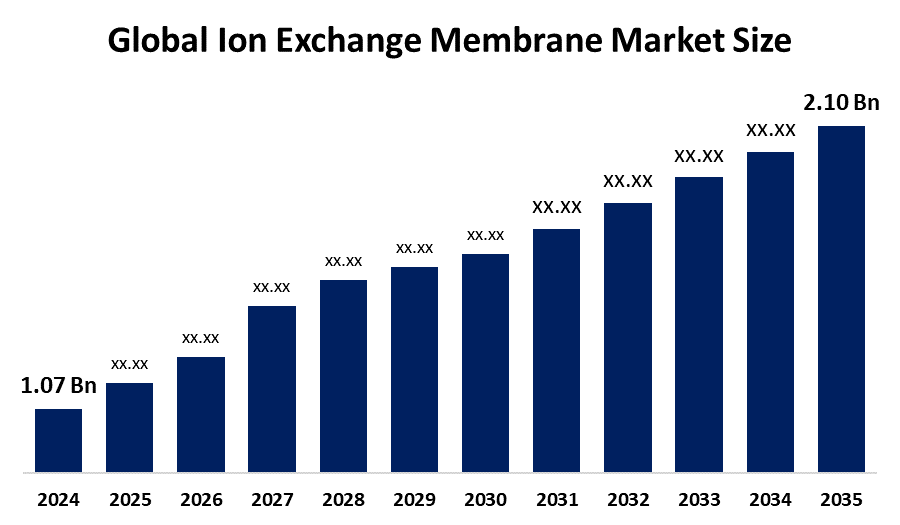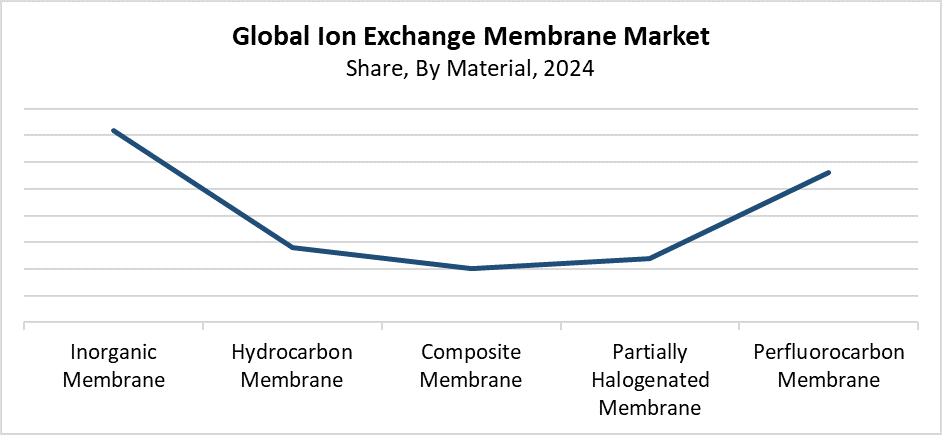Global Ion Exchange Membrane Market Size, Share, and COVID-19 Impact Analysis, By Material (Inorganic Membrane, Hydrocarbon Membrane, Composite Membrane, Partially Halogenated Membrane, Perfluorocarbon Membrane), By Application (Water Treatment, Electrodialysis, Electrolysis, Storage Batteries, Other Applications), and By Region (North America, Europe, Asia-Pacific, Latin America, Middle East, and Africa), Analysis and Forecast 2025 - 2035
Industry: Energy & PowerIon Exchange Membrane Market Summary
The Global Ion Exchange Membrane Market Size Was Estimated at USD 1.07 Billion in 2024 and is Anticipated to Reach USD 2.10 Billion by 2035, Growing at a CAGR of 6.32% from 2025 to 2035. The market for ion exchange membranes is expected to rise as a result of growing industrial wastewater treatment, growing need for clean water, growing application in energy-generating devices such as fuel cells and redox flow batteries, and government policies supporting sustainable energy and environmental solutions.

Get more details on this report -
Key Regional and Segment-Wise Insights
- In 2024, the Asia Pacific region held the largest revenue share of 43.5%, and led the ion exchange membrane market globally.
- In 2024, the inorganic membrane segment accounted for the largest revenue share of 36.4%, dominating the market based on material.
- In 2024, the water treatment segment held the largest revenue share of 43.6%, dominating the market based on application.
Global Market Forecast and Revenue Outlook
- 2024 Market Size: USD 1.07 Billion
- 2035 Projected Market Size: USD 2.10 Billion
- CAGR (2025-2035): 6.32%
- Asia Pacific: Largest market in 2024
The Ion Exchange Membrane Market Size operates through the sale of membranes which enable ion transfer while blocking other substances. These membranes find their main applications in chemical processing, water treatment, energy production, and food and beverage industries. These membranes play a vital role in electrochemical systems which include fuel cells, electrolysis, and electrodialysis operations. The market experiences growth because of two main factors which include the need for advanced wastewater treatment systems. The rising global requirement for clean water is caused by urban growth and industrial expansion. The demand for ion exchange membranes has grown because renewable energy systems have expanded their use of fuel cells and hydrogen production facilities. The market growth depends on strict environmental regulations and public comprehension about sustainable energy and water management.
The market for ion exchange membranes is being greatly influenced by technological developments. Scientists have produced membranes that perform at a high level while showing both chemical resistance and extended durability for use in tough industrial environments and efficient energy systems. The growing interest in green hydrogen production, along with proton exchange and anion exchange membrane advancements, has resulted in expanding application possibilities. The government supports ion exchange membrane development through programs which back clean energy projects and enforce water discharge rules, and provide financial rewards for green technology implementation.
Material Insights

Get more details on this report -
The inorganic membranes segment held the largest revenue share of 36.4% in 2024 and dominated the ion exchange membrane market. The inorganic membranes maintain their upper hand because they provide better mechanical stability, chemical resistance, and thermal stability than organic membranes, which makes them suitable for tough industrial environments, including wastewater treatment, power generation, and chemical processing. The long service life and strong contamination resistance of inorganic membranes, which consist of ceramics and metal oxides. This results in better operational efficiency and lower maintenance expenses. The market for inorganic ion exchange membranes will maintain its lead position because these membranes prove essential for handling high-temperature and aggressive chemical environments in various industrial applications.
The perfluorocarbon membrane segment of the ion exchange membrane market is expected to grow at the fastest CAGR throughout the forecast period because it exhibits exceptional proton conductivity and strong thermal stability, and chemical resistance. The membranes perform best in applications which need high performance, such as fuel cells, chlor-alkali production, and green hydrogen electrolysers. These membranes prove better than traditional membranes because they provide strong performance in challenging chemical and electrochemical situations. The world requires more perfluorocarbon membranes because industrial sectors and clean energy initiatives need them. The segment will experience further expansion during the projection period because of continuous technological progress. Rising financial support for renewable energy development.
Application Insights
The water treatment segment led the ion exchange membrane market with the largest revenue share of 43.6% in 2024. The worldwide residential, commercial, and municipal sectors require safe, clean water. This drives this outstanding achievement. The ion exchange membranes serve as a common solution for desalination and wastewater treatment, and water purification because they provide efficient removal of heavy metals, salts and organic contaminants. Environmental rules, along with water scarcity concerns and sustainable water management needs, have accelerated the adoption of these technologies. The market leadership of this segment receives backing from urbanisation and industrialisation growth in developing countries. This drives the need for advanced water treatment solutions.
The storage batteries segment of the ion exchange membrane market is expected to grow at the fastest CAGR during the forecast period because sustainable and effective energy storage solutions continue to grow in demand. Ion exchange membranes form the core component of redox flow batteries, which serve as large-scale energy storage systems. This is because they provide extended operational life and renewable energy system compatibility. The demand for better battery technology continues to increase because electric mobility and renewable energy storage, and grid stability become essential for global operations. The market grows because membrane material development focuses on improving conductivity and durability, and reducing costs to establish this sector as essential for the evolving energy environment.
Global Ion Exchange Membrane Market Report Coverage
| Report Coverage | Details |
|---|---|
| Base Year: | 2024 |
| Market Size in 2024: | USD 1.07 Billion |
| Forecast Period: | 2025-2035 |
| Forecast Period CAGR 2025-2035 : | CAGR of 6.32% |
| 2035 Value Projection: | USD 2.10 Billion |
| Historical Data for: | 2020-2023 |
| No. of Pages: | 240 |
| Tables, Charts & Figures: | 120 |
| Segments covered: | SUEZ, Saltworks Technologies Inc. |
| Companies covered:: | 3M, ResinTech, Hyflux Ltd., AGC ENGINEERING Co. Ltd, Merck KGaA, ION EXCHANGE, Evergreen Technologies Pvt Ltd, LANXESS, DuPont de Nemours, Inc., SUEZ, Saltworks Technologies Inc., Membranes International Inc., and Other Ley Players. |
| Pitfalls & Challenges: | COVID-19 Empact, Challenge, Future, Growth, & Analysis |
Get more details on this report -
Regional Insights
The Asia Pacific ion exchange membrane market dominated worldwide by generating the largest revenue share of 43.5% in 2024. The industrial growth and population expansion, together with increasing needs for energy, clean water in China, India, Japan, and South Korea, create the main reasons for this dominance. The region has received major funding for desalination plants and wastewater treatment facilities, and renewable energy developments that focus on fuel cells and hydrogen production because ion exchange membranes function as vital components in these systems. Environmental laws and government programs support sustainable infrastructure development and clean energy technology advancement. They drive the market toward growth. The Asia Pacific area keeps its market leadership because major manufacturers operate there, and research activities for membrane technology continue to grow.
North America Ion Exchange Membrane Market Trends
The North American market for ion exchange membranes experiences continuous growth because of increasing requirements for renewable power, energy storage, and advanced water purification systems. The United States and Canada lead the adoption of fuel cells, redox flow batteries, and hydrogen generation systems because these technologies need high-performance ion exchange membranes. Membrane-based separation and purification technology investments surge because environmental rules become stricter, while water scarcity intensifies, and industries seek sustainability in their operations. The government supports clean energy projects through funding and incentives. These, together with essential technology providers and research institutions, help speed up both innovation and implementation processes. North America has established itself as a leading force in the global market because of these factors.
Europe Ion Exchange Membrane Market Trends
The European ion exchange membrane market held a significant revenue share during 2024 because the area focuses heavily on sustainable practices, clean energy solutions, and modern water treatment systems. The Netherlands, Germany, and France lead the world in adopting high-performance ion exchange membranes, which power green hydrogen production and fuel cell technologies, and wastewater recycling systems. The European Union enforces strict environmental rules and climate targets, which drive companies to adopt sustainable and energy-saving solutions. The market growth receives additional support from major public and commercial research funding, together with governmental programs. These promote carbon neutrality and circular economy development. The European ion exchange membrane market maintains its global leadership because Europe continues to innovate while focusing on clean technology development.
Key Ion Exchange Membrane Companies:
The following are the leading companies in the ion exchange membrane market. These companies collectively hold the largest market share and dictate industry trends.
- 3M
- ResinTech
- Hyflux Ltd.
- AGC ENGINEERING Co. Ltd
- Merck KGaA
- ION EXCHANGE
- Evergreen Technologies Pvt Ltd
- LANXESS
- DuPont de Nemours, Inc.
- SUEZ
- Saltworks Technologies Inc.
- Membranes International Inc.
- Others
Recent Developments
- In September 2024, an Italian multinational corporation called Industrie De Nora, which is listed on Euronext Milan and specialises in green hydrogen and sustainable electrochemical technologies, is introducing a regional version of its CECHLO-MS 200 ion exchange membrane electrolysis (IEM) technology for the North American market.
- In February 2021, Hydrogen power production technology supplier AFC Energy announced the opening of its Anion Exchange Membrane (AEM) fuel cell test facility, which will be located at the company's Surrey headquarters in the UK.
Market Segment
This study forecasts revenue at global, regional, and country levels from 2020 to 2035. Spherical Insights has segmented the ion exchange membrane market based on the below-mentioned segments:
Global Ion Exchange Membrane Market, By Material
- Inorganic Membrane
- Hydrocarbon Membrane
- Composite Membrane
- Partially Halogenated Membrane
- Perfluorocarbon Membrane
Global Ion Exchange Membrane Market, By Application
- Water Treatment
- Electrodialysis
- Electrolysis
- Storage Batteries
- Other Applications
Global Ion Exchange Membrane Market, By Regional Analysis
- North America
- US
- Canada
- Mexico
- Europe
- Germany
- UK
- France
- Italy
- Spain
- Russia
- Rest of Europe
- Asia Pacific
- China
- Japan
- India
- South Korea
- Australia
- Rest of Asia Pacific
- South America
- Brazil
- Argentina
- Rest of South America
- Middle East & Africa
- UAE
- Saudi Arabia
- Qatar
- South Africa
- Rest of the Middle East & Africa
Need help to buy this report?